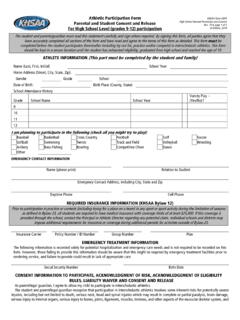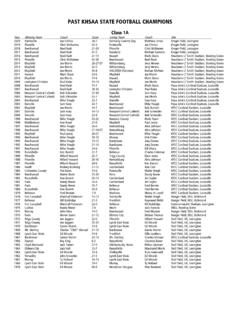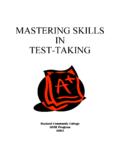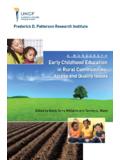Transcription of NASP Tournament Manual - khsaa.org
1 1 NASP Tournament Manual A Guide for a NASP Sanctioned Tournament 2 I. Introduction Since 2002, thousands of schools and millions of students throughout five countries have participated in the National Archery in the Schools Program (NASP ). Many have stated that NASP is the most successful shooter development program in history. Educators, conservationists, and students alike offer tremendous praise when asked to describe their experience with NASP . However, even though the successes are many, there are still many more schools and students that could benefit from this exciting program! And while the program has covered much ground, there are still some who have yet to discover the current and potential impact of NASP . Several components have led to the success of NASP over the past several years. Standardized equipment, training, and curriculum has allowed for maximum participation and simplicity for students , coaches, and schools.
2 In addition, the NASP has proved to be an exceptionally popular tool to generate excitement, promote regular practice, create NASP clubs, and to bring together participating schools from all over the country. The NASP is not necessarily an end in itself, however it is a tremendous culminating event to reward the hard work of NASP archers everywhere. The purpose of this Manual is to provide instruction and tips in conducting a highly successful NASP Tournament . Depending on size of your program and the number of participants, the size, length, and details of the Tournament will change. For instance, if you have just begun the NASP , you may only have a couple hundred shooters or less which means you can conduct your Tournament in a smaller venue with less manpower. However, you may have a veteran NASP and have a couple thousand!
3 In this case your venue may be larger, the Tournament length longer, and the Tournament will require more help. This Manual will cover a variety of topics and will attempt to be as comprehensive as possible in speaking to every circumstance a coordinator may encounter, and it will certainly provide answers to the most important questions, such as: What do I need to know in preparing for the Tournament ? Who participates? What are the financial considerations? How long should the Tournament last? and much more. After following this Manual , a new NASP Coordinator 3 will be able to conduct a successful NASP Tournament ! It should be noted that this Manual is a representation of the NASP National Tournament . Rules, recommendations, and procedures are specific to the national program. 4 II. NASP Tournament Participants A.
4 Team Aspects NASP wants to make sure that anyone who would like to participate in archery gets an opportunity. Therefore, many of the Tournament regulations are in place to ensure that all sorts of students can participate, not just the elite archers. However, it is also important to note that due to the success of the program and the number of participants, NASP is unable to accommodate every archer in the Tournament . For this reason, there must be limits based on score and positioning to which teams advance to regional, state, national, and world tournaments. For a detailed look at the official NASP Rules and Regulations, see Appendix A at the back of this Manual . Below is a list of some of team regulations as it relates to participants. 1. A team must come from NASP participating school . In relation to the national Tournament , as school must be from a NASP participating state as well.
5 It is important to the integrity of the program and the overall mission of NASP that all teams, or individuals, have come from schools that have conducted the NASP , in school , during that school year. 5 2. A team and its members must be in grades 4-12. While some elementary schools and colleges use NASP instruction and equipment, the Tournament only allows for those participants in grades 4-12. See Appendix A under " Tournament Rules" to see exceptions. 3. 1st place teams in Elementary (grades 4-6), Middle (7-8), and High school from NASP State or Provincial tournaments can participate. In addition: a. Teams with the following qualifying scores (qualifying score = sum top 12 archers with at least 4 of the opposite gender) may participate: i. Elementary school qualifying score is 2,800 points ii. Middle school qualifying score is 2,900 points iii.
6 High school qualifying score is 3,000 points b. Male & female Individuals who place 1st-5th in 4th, 5th, & 6th grades and, Middle, and High school Divisions may also participate 4. A NASP Team consists of 16-24 students , at least 5 of which must be of the opposite gender. This regulation is especially important to the mission of NASP . Considering that only the top 12 individual scores count for the team (which must include 4 of the opposite gender), it would be easy, and more cost effective, for schools only to select their top 12 shooters to participate in the Tournament . However, NASP wants everyone to get to experience the thrill of participating in an archery Tournament . So while some of those archers on your team may not have the top score, they have still had the opportunity to participate with others in the Tournament and can experience success!
7 In addition, NASP is a co-ed program! NASP wants to make sure that no matter if a student is a girl or a boy, that student will have an opportunity to participate in a meaningful way towards the team's success. 5. If a school is of a single gender, opposite gender participants may come from other NASP schools as long as they are from the same city, county, or school district. NASP realizes that not all schools are the same! In this case, accommodations are made so that as many students as possible can participate. 6. If a school contains less than 150 students (combination of all grades), the team may be comprised of students from other participating NASP schools in the same city, county, or school district. In some cases, especially with private schools or home- 6 school associations, there may be less students to participate than is required.
8 In this case, accommodations are made. These are limited cases so that schools do not join together in order to create an "All-Star Team" and an unfair advantage. B. Individual Competitors In addition to team competition, each archer also competes individually. Even though a student's team may not have placed high enough in their state Tournament , as long as the male or female archer places 1st-5th in the elementary, middle, or high school division, they may also participate in the national Tournament . III. Tournament Preparation There are many items of preparation that must be taken into account as a coordinator is planning for their Tournament . From venue size to number of quivers, each detail should be worked out far enough in advance to accommodate any changes that need to be made in the final weeks leading up to the Tournament .
9 A particular Tournament 's success is highly dependent upon the amount of time taken in preparation. Below you find a number of items that will help you on your way to planning a very successful archery Tournament . 7 A. Choosing a Venue The venue that is chosen for the archery Tournament is dependent on a variety of factors including number of archers, cost, accessibility, safety, availability, and more. If the venue is too small for the number of archers participating, then your Tournament may take too much time. If the venue is located in a congested and inaccessible location, it will be difficult to navigate and park school buses in addition to spectator parking. The following are a variety of criteria related to venue choice in order to help the coordinator select the appropriate location to hold an archery Tournament .
10 1. Venue Size: the size of your Tournament is dependent upon the number of shooters, spectators, and the desired length of the event. Tournaments can be hosted in traditional gymnasiums, small convention centers, and large Exposition Centers. a. Traditional Gymnasium: Traditional gymnasiums are popular for regional tournaments or small state tournaments because the venue is easy to manage, you generally need less equipment to hang arrow curtains, and they are cost effective. However, you are limited both in the number of shooters that can participate and spectators to watch. If you decided to hold your Tournament in a traditional sized gymnasium, with a basket ball court that is approximately 80 feet, and your flights consist of one (1) line of shooters, you will be able to host approximately 450 shooters in your Tournament over the course of two (2) 9 hr days (16 targets, 8 32 shooters per flight, 14 flights, 75 minutes each).















